Creating family celebrations and festivals
View/download pdf Celebrations
Why family celebrations?
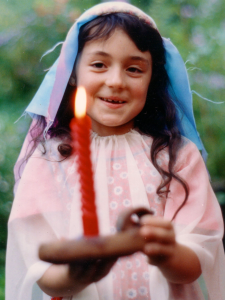 Life at home with children can be rich, creative and more meaningful when we celebrate the small things in daily life with consciousness and creativity. It is an opportunity to share our values with our children, to teach them appreciation, to challenge them to observe nature, to be thoughtful, to be creative and to show initiative.
Life at home with children can be rich, creative and more meaningful when we celebrate the small things in daily life with consciousness and creativity. It is an opportunity to share our values with our children, to teach them appreciation, to challenge them to observe nature, to be thoughtful, to be creative and to show initiative.
Sometimes our celebration can be a very simple ritual, repeated so often that it becomes woven into the fabric of our lives. It may be the way we pull the curtains back in our child’s room each day and say good morning to the sun, and “thank you for a bright new day”. It may be the way, when putting a small child to bed, we light a candle, and quietly say a blessing, which surrounds them with love to keep them safe, and then softly sing a lullaby before kissing them goodnight. It may be the way we prepare for a parent or child’s homecoming after a trip away, with a special card, a sign of welcome on the door, and a special meal where the story of their adventures can be told.
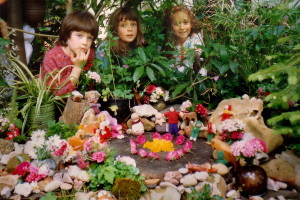
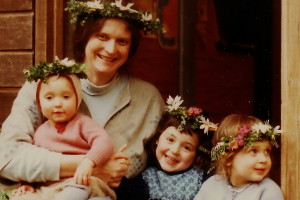
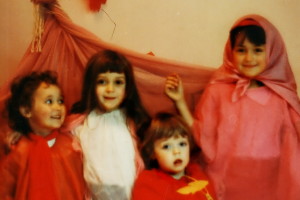
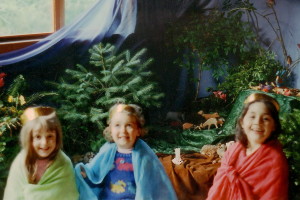
Or it may be a little more complicated, like a little festival welcoming the spring, with friends to join us, a story to tell, some singing and a shared meal. Or a ceremony to bury a beloved cat which has died. Or a simple song and story for the lighting of the Advent candles. Or a candle lighting at Christmas for all those we love. A review of the year’s events and blessings for the coming year in a special New Year’s Eve meal.
There are so many things in our lives to be acknowledged, valued and celebrated. How can we live with awareness and appreciation of the natural world around us? How can we celebrate the richness of what the rhythms of nature bring in the seasons, in the year?
How do we welcome each fresh new day and the sun with optimism? How do we complete each day with gratitude for what it brought us? How do we prepare a child for the gift of good sleep? How can we bring a supportive predictable rhythm to the days of the week, in the seasons of the year, for children?
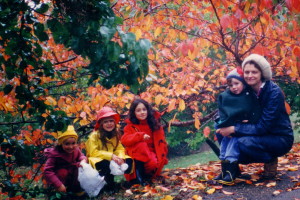
How do we help make transitions more conscious and complete? How can we say goodbye to things gracefully, with gratitude? How do we acknowledge a new start? How can we celebrate with more consciousness the special moments in our lives? How do we welcome the people we love?
How do we make all this part of our lives? We can do all these things with small celebrations, developed with consciousness, appreciation, and acknowledgement.
What do our children learn from all this? That life is rich, meaningful and beautiful.
Some reminders about what is worth celebrating
- Every day special times: morning/sun rise, midday, evening/sunset, night
- Days of the week: Monday, Tuesday, Wednesday, Thursday, Friday, Saturday, Sunday
- Months of the year: what happens, what grows
- Seasons of the year: Spring, Summer, Autumn, Winter
- Everyday special times: meal times, story time, sleep
- Yearly special times: birthdays, anniversaries, death days/remembering days, new year
- Transitions times/beginnings & endings: first day of school, moving house, house blessings
- Journeys: goodbyes, welcomes
- Special religious festivals: Christmas/Easter/Christian festivals/Ramadan/Hannukkah/other religious festivals.
- Other festival traditions: Halloween, Valentine’s Day, Mother’s Day, Father’s Day, Chinese New Year
- Other traditions in your family (e.g. holidays in the same place each year)
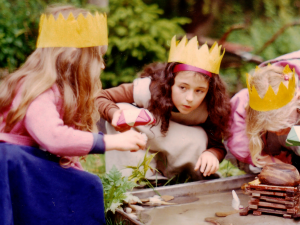
Creating a celebration or festival
1. Clarify your aims.
What ideas are you trying to express in this celebration? What values are you trying to support within your family’s belief system? For example: What do you believe about birth and death, about beginnings and endings, about the values implicit in traditional festivals such as Christmas or Easter? What attitudes towards nature and the earth do you want to develop in your children? What are the basic attitudes you want to encourage in everyday living and in other people— in how we greet the day, each other, our troubles and our blessings?
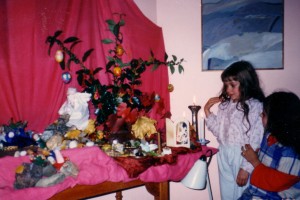
Consider how you can create a satisfying celebration of an event or festival experience which enriches you and your family in body, soul and spirit. Some celebrations will of necessity be simple and short but others offer the opportunity to nourish yourselves in varied ways: festive foods, social activities, music, poetry, stories, plays, magic moments, beauty, flowers and artistic activities. Thoughtful content can give a celebration meaning and substance, can nourish us in endless ways and enrich family life immeasurably.
Note that the deepest meaning of the celebration is carried in the minds and hearts of the active adults. Without this clarity and commitment, the celebration becomes merely an “activity”, no doubt still valuable in its own way, but with less likelihood of becoming a more profound experience for all.
For whom? Who is the celebration for? It is a richer experience if every person coming is involved in some way and brings something for the festival – food, flowers, a song, a thought etc.
When and what time of day, for how long? Consider the limitations on concentration of the children. It is mostly better to have a short well-formed formal festival followed by a looser organisation of social activities, eating, games etc.
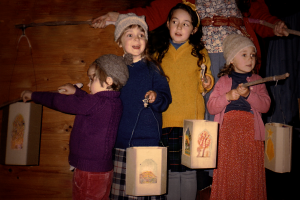
2. Content of the celebration
Content – this can be anything that can add to the meaning and enjoyment of your celebration: special thoughts to bring meaning, blessings, stories, artistic items of music, poetry, prose, decorations, dress, food, games, activities, a celebration table.
3. Preparations for the celebration
Children love to look forward to a celebration and be involved in its preparation. For example in making lanterns, candles, special food, gifts, garlands, going on walks to collect natural things, or making decorations.
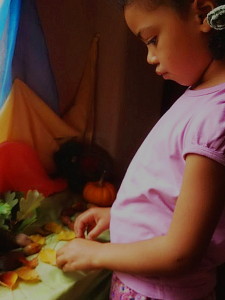 The celebration table: A “celebration table” (or shelf or small surface) can be a focus for preparing children for the coming celebration. Such a table can be used for celebrating the seasons, special days and events in our lives. You could consider using coloured cloths, pictures, beautiful natural objects and things collected on walks and visits, a candle, flowers, a tableau of little dolls in a scene/tableau etc. It can also be used in the celebration itself.
The celebration table: A “celebration table” (or shelf or small surface) can be a focus for preparing children for the coming celebration. Such a table can be used for celebrating the seasons, special days and events in our lives. You could consider using coloured cloths, pictures, beautiful natural objects and things collected on walks and visits, a candle, flowers, a tableau of little dolls in a scene/tableau etc. It can also be used in the celebration itself.
Songs and stories: Are there songs to learn or stories to be told in preparation?
4. The formal celebration organisation
The ‘content’ of the festival needs to be organised into a balanced programme. Consider the preparation for the celebration, how it will begin, or be introduced, what will be its major focus and how will it be brought to a conclusion? Who will lead into the beginning of the festival, and how? How can you lead from one activity to another, and how can you gather it together at the end? Who will speak the simple thoughts that tie it all together and make its meaning clear?
The success of a formal celebration or festival is greatly enhanced by the thoughtful attention to detail in the way it is put together. It is like directing a performance. Little things, like having the matches in the right place for lighting the candles, people knowing when they are to do things, having musical instruments ready to play on cue etc., help to keep the organisation tight so that the focus can stay on the content. Tight order also helps to keep the reverence and wonder in place. Disorganisation creates loose boundaries, where the special time blurs into the ordinary.
The structure of a celebration
Here is one suggestion for the structure of a celebration or festival. There are of course many ways. Each celebration will be different.
The beginning sign. Every celebration needs a sign that it is about to begin, a boundary marker that signifies when we shift from everyday living into the “sacred”/ the celebration. It is important that everyone recognises this. Simple music, a song or a bell are useful symbols of beginnings and endings. Music does this simply, because it speaks to a different part of our soul, but one could use other ways as well—a moment of stillness, a candle being lit, a clearly spoken line or blessing, a different tone of voice etc.
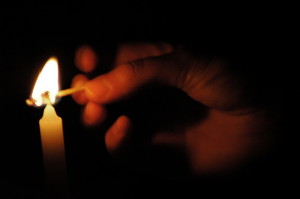
The introduction. The introductory words can bring meaning with beauty and reverence. Something needs to be said to bring our theme clearly before us as participants in the celebration—not a long speech but a clear and beautiful picture of what we are doing, e.g. “Today we are welcoming back the fullness of the warmth and light of the sun at the summer solstice…” “This festival table is a welcome to our dear new baby who is coming to our family…” “We light this candle for our friend Marjory who has left her worn out, old and weary earthly body and is now free to go on with her spiritual journey…” “Today we are celebrating just because spring has come to our garden and we are so glad to have our beautiful delicate new birch leaves tell us so…”
Focus/climax. We need to be clear about what the focus and climax of our celebration is. What is the key activity that makes the focus for the whole celebration? This might be a story for our hearts, or an action, like planting a tree, cutting a cake, lighting a candle in a special way, or saying a special verse.
Ending. This needs to lead us gently away from the climax, perhaps restate our purpose and to create the other boundary… a clear passing from the sacred back into the secular…more music, a blessing, a silence as we “take the light of the candle into our hearts” as we snuff it.
Every family needs to develop their own ways of celebrating life and events. Some things will work better than others, at some times but not others. You will discover this as you go along. The important thing is to be courageous, creative and to use all the skills you have to bring richness to your life together and to your celebrations: ideas and values, all the arts, music, poetry, stories, art, craft, love of nature, practical activities, adventures, creative cooking, fun and wonder. This is what makes life rich, meaningful and beautiful.
View/download pdf Celebrations
Resources for celebrations and festivals
Many books are available which provide resources and inspiration for celebrations, big and small and can be found particularly in bookshops serving the Steiner Waldorf School communities.
Online one place these can be found is at www.rudolfsteinerbookcentre.com.au
In a search under ‘festivals’ there are books which provide stories, songs, activity ideas and food recipes for different celebrations including multicultural festivals. There are also books about making daily rhythms more special. Festivals Family and Food by Diana Carey & Judy Large (Hawthorn Press, 1983) is an old favourite to begin with.
See also
Creating a peaceful, meaningful Christmas
Creative parenting of the whole child
Love gifts
Strategies for healthy living with young children
Building self-esteem and resilience